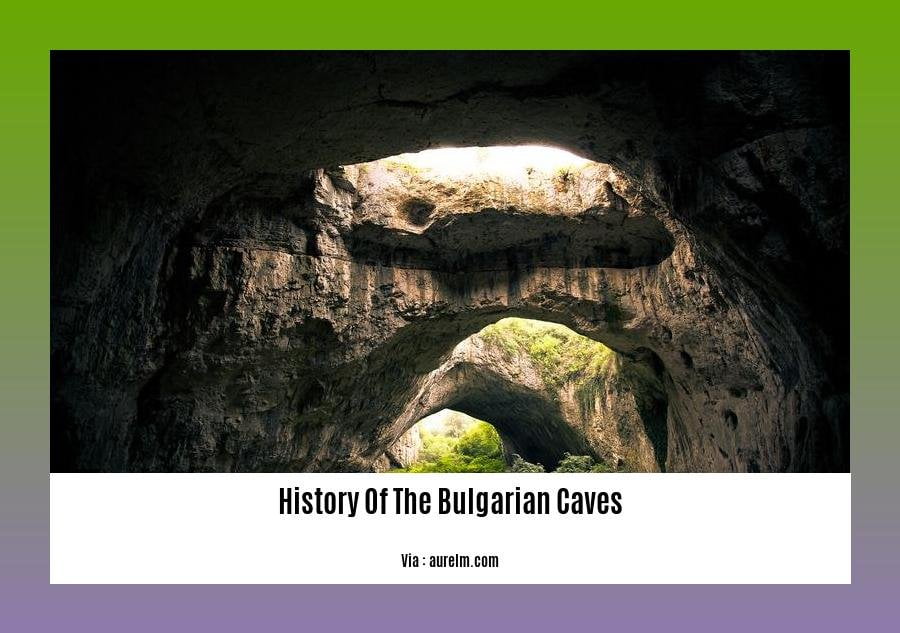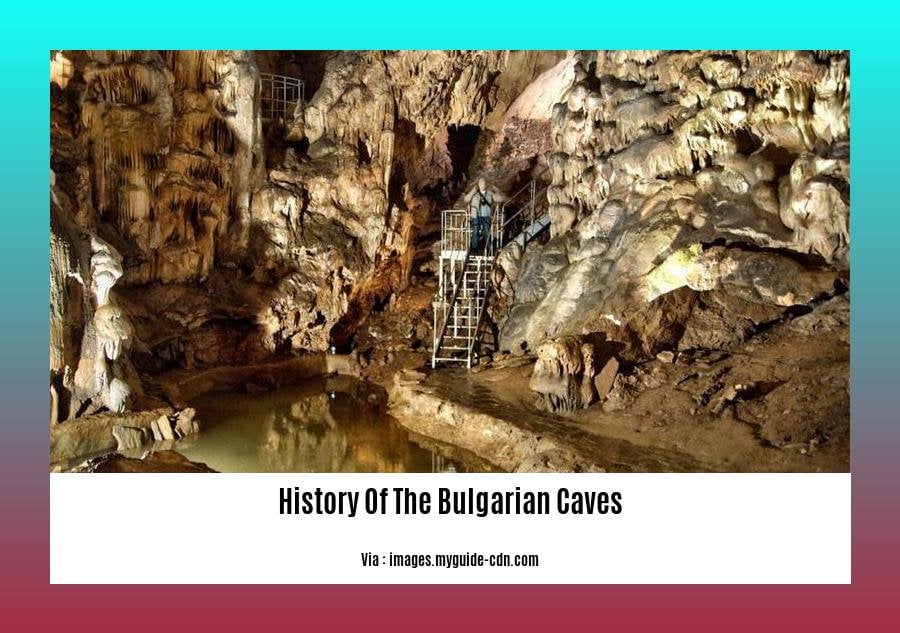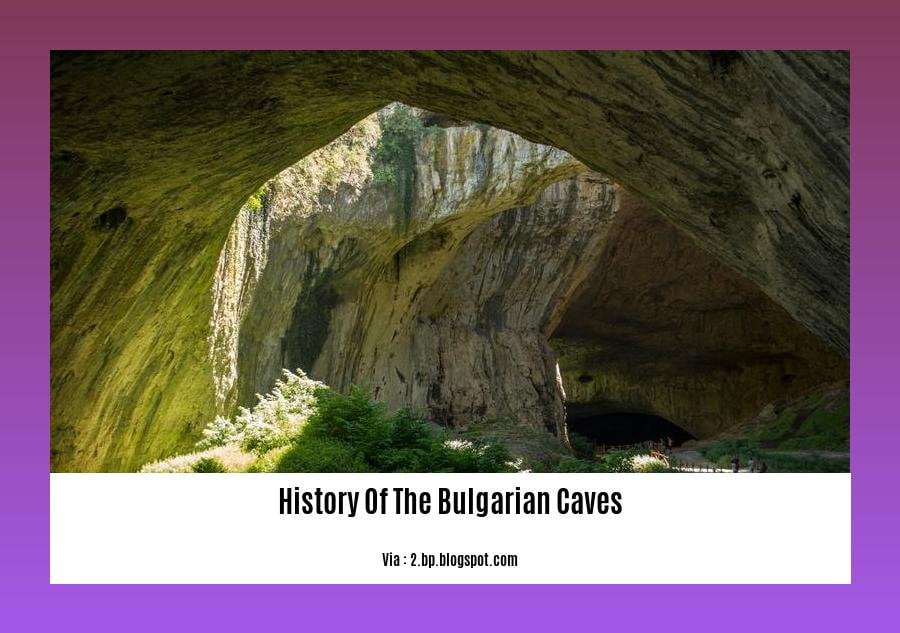Step into the enchanting realm of [- Unraveling the Enigmatic History of the Bulgarian Caves: A Journey Through Time and Discovery]. Dive into the depths of these subterranean wonders, where ancient mysteries intertwine with breathtaking geological formations and echoes of forgotten civilizations beckon from the darkness.
Key Takeaways:
Bulgaria is home to over 700 caves, making it a popular destination for cavers and nature enthusiasts.
Caves in Bulgaria range in length from a few hundred meters to over 18 kilometers and offer various features, including stalactites, stalagmites, and underground rivers.
Some of the most popular caves in Bulgaria include Devetashka Cave, Bacho Kiro Cave, and Duhlata Cave.
Bulgaria’s caves are protected by law, and visitors need a permit to enter them. Guided tours are available at most popular caves.
Resources:
- List of Caves in Bulgaria – Wikipedia
- 12 Of The Most Beautiful Caves In Bulgaria
History of the Bulgarian Caves

The Bulgarian caves are a treasure trove of historical and archaeological wonders, inviting us on a journey through time and discovery. Their hidden chambers and subterranean galleries have preserved evidence of human presence dating back thousands of years, providing valuable insights into the lives and cultures of our ancestors.
The Geological Formation of Bulgarian Caves
The history of the Bulgarian caves is intricately linked to the country’s unique geology. The caves were formed over millions of years through the relentless work of water erosion, shaping the limestone and karst landscapes that characterize Bulgaria. The country’s diverse geological formations, including karst plateaus, canyons, and valleys, have created the perfect conditions for the development of a rich and varied cave system.
Archaeological Discoveries in Bulgarian Caves
The Bulgarian caves have yielded a wealth of archaeological discoveries, shedding light on the lives of prehistoric humans and the development of human civilization in the region. Evidence of human occupation dates back to the Paleolithic era, with artifacts such as stone tools, animal bones, and cave paintings providing glimpses into the daily lives and artistic expressions of our ancestors. Later periods, including the Neolithic, Bronze, and Iron Ages, are also represented in the archaeological record found in the caves.
Cultural Significance of Bulgarian Caves
Beyond their historical and archaeological significance, Bulgarian caves hold deep cultural and spiritual importance. Many caves are associated with local legends, myths, and folklore, weaving a tapestry of stories that connect the past with the present. Some caves are believed to have been used as sacred sites or places of worship, while others are said to be haunted by spirits or supernatural beings.
Exploring the Bulgarian Caves
Today, the Bulgarian caves are a popular destination for cavers, explorers, and nature enthusiasts. Guided tours are available at many of the most accessible caves, allowing visitors to safely explore their vast chambers, intricate formations, and hidden passages. Whether you’re an experienced caver or simply seeking a unique and awe-inspiring experience, the Bulgarian caves offer an unforgettable journey into the depths of history and the wonders of the natural world.
Delve into the allure of Bulgaria’s concealed wonders by exploring its captivating caves, where nature’s artistry adorns the subterranean realm. Journey through time as you uncover the history of Bulgaria through the lens of ancient ruins and vibrant traditions. Seek answers to the intriguing question of where did the Bulgarians come from by tracing their nomadic origins and rich cultural tapestry. Unravel the enigmatic roots of the Bulgars as we delve into their migration, settlement, and profound impact on Bulgarian identity.
History Of The Bulgarian Caves Map

From the depths of the Earth, the enigmatic caverns of Bulgaria whisper tales of ancient civilizations, hidden treasures, and geological wonders. Embark on a subterranean journey to unravel the rich tapestry of Bulgarian cave history, where nature’s artistry intertwines with human history, mystery, and folklore.
Key Takeaways:
- Bulgaria boasts an astonishing 4,500+ underground formations, each a testament to the country’s dynamic geological past.
- The earliest records of Bulgarian caves date back to the 17th century, penned by Petar Bogdan, a notable historian during the Bulgarian National Revival.
- These caves hold immense cultural and archaeological significance, with evidence suggesting human habitation and artistic expression spanning millennia.
- Notable caves like Bacho Kiro, Devetashka, Trigrad Gorge, and Ledenika captivate visitors with their unique geological formations and historical allure.
- Many Bulgarian caves are accessible to the public, offering guided tours that reveal their natural beauty and historical significance.
From the earliest writings to modern explorations, the history of Bulgarian caves is a captivating narrative of human curiosity, scientific discovery, and the enduring allure of the unknown.
Geological Tapestry: A Canvas of Time
Bulgaria’s caves showcase a diverse range of geological formations, each a masterpiece sculpted by time and the forces of nature. Stalactites, stalagmites, and flowstones drip with crystalline beauty, while subterranean rivers carve intricate patterns into the cave walls. The intricate chambers and passages reveal the dynamic history of the region, where tectonic shifts, water erosion, and mineral deposits have collaborated to create these subterranean wonders.
Archaeological Treasures: Uncovering Ancient Secrets
The caves of Bulgaria serve as time capsules, preserving evidence of human presence dating back to prehistoric times. Archaeological discoveries within these caves, such as stone tools, pottery fragments, and artwork, provide glimpses into the lives of ancient civilizations. The caves bear witness to the ingenuity and resilience of our ancestors, who sought shelter, conducted rituals, and left behind artistic expressions that continue to captivate us today.
Cultural Heritage: Legends and Folklore
Bulgarian caves are woven into the fabric of local culture, inspiring legends, myths, and folklore that have been passed down through generations. These tales speak of hidden treasures guarded by mystical creatures, secret passages leading to enchanted realms, and spirits that dwell within the caves’ depths. The caves’ rich cultural heritage adds an ethereal dimension to their exploration, inviting us to contemplate the interplay between human imagination and the mysteries of the underworld.
Accessible Wonders: Unveiling the Hidden Realm
While some caves remain pristine and accessible only to experienced cavers, many Bulgarian caves welcome visitors with guided tours. These tours provide a safe and informative way to explore the caves’ natural beauty, learn about their geological formations, and discover their historical and cultural significance. As you navigate the subterranean labyrinth, you’ll feel the awe-inspiring presence of nature’s artistry and the enduring legacy of human history.
A Journey of Discovery: Past, Present, and Future
The Bulgarian caves stand as a testament to the power of nature, the resilience of human spirit, and the ongoing quest for knowledge. As we delve deeper into these subterranean realms, we uncover not only geological wonders but also glimpses into our shared past. The History Of The Bulgarian Caves Map is an invitation to embark on a journey of discovery, where every twist and turn reveals a new chapter in the ever-evolving story of human and natural history.
Sources:
[1] “List of Caves in Bulgaria” (Wikipedia)
[2] “Official Site of the Bulgarian Tourist Union”]
References:
Drawing upon the enchanting history of Bulgaria’s caves takes us on a captivating journey through time. With over 4,500 underground formations, Bulgaria beckons cavers and history enthusiasts alike to unravel enigmatic tales concealed within these subterranean realms. The earliest written accounts of these caves date back to the 17th century, offering glimpses of a world hidden beneath the surface.
Key Takeaways:
- Bulgaria boasts an impressive 4,500 caves, making it a haven for cave exploration and discovery.
- The earliest written records of these natural wonders date back to the 17th century, providing a historical lens into their captivating past.
- Bulgarian caves hold immense cultural and archaeological significance, with evidence of prehistoric human habitation and artistic expression.
- Notable caves like Bacho Kiro, Devetashka, Trigrad Gorge, and Ledenika captivate visitors with their unique geological formations and historical allure.
Numerous caves in Bulgaria welcome visitors with open arms, inviting them to embark on guided tours that illuminate their beauty and historical significance. These tours unveil majestic stalactites, stalagmites, flowstones, and intricate chambers carved by the relentless forces of water erosion.
Archaeological treasures discovered within these caves provide invaluable insights into prehistoric human civilizations and their way of life. Artifacts, tools, and remnants of ancient hearths paint a vivid picture of past inhabitants, their resilience, and their deep connection to the subterranean realm. Exploring these caves feels like a journey back in time, connecting us with our ancestors and the echo of their footsteps through the ages.
Beyond their tangible treasures, Bulgaria’s caves are intertwined with local culture, inspiring legends, myths, and folklore that add a mystical dimension to their exploration. Tales of hidden chambers, supernatural beings, and long-lost treasures weave a tapestry of enchantment around these underground wonders. These stories ignite our imagination and transport us to a realm where reality and fantasy dance harmoniously.
Whether you are an experienced caver seeking pristine subterranean landscapes or a curious traveler eager to discover the hidden depths of history, Bulgaria’s caves beckon you to embark on a journey of discovery. Their captivating formations, rich archaeological heritage, and cultural significance promise an adventure that will linger in your memory long after you surface into the light.
Further Reading:
- List of Caves in Bulgaria – Wikipedia
- 12 Of The Most Beautiful Caves In Bulgaria
FAQ
Q1: When were the earliest written records of caves in Bulgaria discovered?
A1: The earliest known written records of caves in Bulgaria date back to the 17th century, thanks to the efforts of Bulgarian National Revival figure and historian Petar Bogdan.
Q2: Which is the longest cave in Bulgaria?
A2: The longest cave in Bulgaria is Duhlata Cave, also known as Oryahovo Cave, which stretches over 18 kilometers in length.
Q3: What is the significance of Bacho Kiro Cave?
A3: Bacho Kiro Cave holds great historical significance as it contains evidence of early human habitation and artwork dating back to the Paleolithic era, making it a crucial site for understanding Bulgaria’s prehistoric past.
Q4: Can tourists visit the caves in Bulgaria?
A4: Yes, some caves in Bulgaria are open to the public for guided tours, allowing visitors to explore and appreciate their stunning geological formations, rich history, and cultural significance.
Q5: What is the most striking feature of Devetashka Cave?
A5: Devetashka Cave is renowned for its large chamber, which boasts a height of over 100 meters, making it a fascinating natural wonder and a popular destination for both locals and tourists.
- China II Review: Delicious Food & Speedy Service - April 17, 2025
- Understand Virginia’s Flag: History & Debate - April 17, 2025
- Explore Long Island’s Map: Unique Regions & Insights - April 17, 2025
















